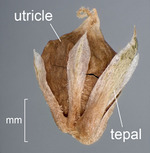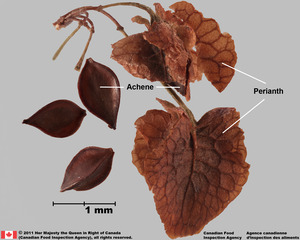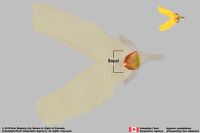Content is from Kirkbride et al. 2006Kirkbride et al. 2006:
Kirkbride JH, Jr, Gunn CR, and Dallwitz MJ. 2006. Family guide for fruits and seeds, vers. 1.0. Accessed September 2020-January 2022. URL: https://nt.ars-grin.gov/seedsfruits/keys/frsdfam/index.cfm ., without modification.
Updates are forthcoming.
Fruits: Pistil(s) simple, or compound; 1; 1-pistillate; with carpels united. Fruit anthocarpanthocarp:
simple or compound and including some tissue of non-ovarian origin (accessory tissue) , or pericarpium; simple; capsulecapsule:
, or pericarpium; simple; capsulecapsule:
a dry, dehiscent fruit derived from a compound ovary ; loculicidalloculicidal:
; loculicidalloculicidal:
type of capsular dehiscence, opening longitudinally through the locules (compare septicidal)
 capsulecapsule:
capsulecapsule:
a dry, dehiscent fruit derived from a compound ovary ; capsulecapsule:
; capsulecapsule:
a dry, dehiscent fruit derived from a compound ovary not inflated; capsulecapsule:
not inflated; capsulecapsule:
a dry, dehiscent fruit derived from a compound ovary without operculumoperculum:
without operculumoperculum:
a dehiscent cap (or lid) of a seed or fruit that opens during germination or dehiscence ; simple; diclesium (Phryma); without persistent central column; valves not diverging at top of central column; with styles(s); at apexapex:
; simple; diclesium (Phryma); without persistent central column; valves not diverging at top of central column; with styles(s); at apexapex:
the point farthest from the point of attachment, or the "tip" of an organ ; within accessory organ(s); within calyxcalyx:
; within accessory organ(s); within calyxcalyx:
the outer whorl of the perianth; all the sepals of a flower , or tepals; accrescentaccrescent:
, or tepals; accrescentaccrescent:
growing continuously
; persistent; soft calyxcalyx:
the outer whorl of the perianth; all the sepals of a flower , or hard calyxcalyx:
, or hard calyxcalyx:
the outer whorl of the perianth; all the sepals of a flower (Phryma); tepalstepal:
(Phryma); tepalstepal:
a member of the perianth, when it cannot be differentiated into a calyx and corolla (or perianthperianth:
(or perianthperianth:
collective term for calyx and corolla of a flower
 or sepalssepal:
or sepalssepal:
a member of the outer envelope of a flower (calyx) ) not smooth; tepalstepal:
) not smooth; tepalstepal:
a member of the perianth, when it cannot be differentiated into a calyx and corolla (or perianthperianth:
(or perianthperianth:
collective term for calyx and corolla of a flower
 or sepalssepal:
or sepalssepal:
a member of the outer envelope of a flower (calyx) ) teminal hooks; tepalstepal:
) teminal hooks; tepalstepal:
a member of the perianth, when it cannot be differentiated into a calyx and corolla (or perianthperianth:
(or perianthperianth:
collective term for calyx and corolla of a flower
 or sepalssepal:
or sepalssepal:
a member of the outer envelope of a flower (calyx) ) not forming wings; 1-seeded to many-seeded; 1-seeded (- many); less than 1 cm long; 0.2–0.8 cm long; with 1–2-carpellate; with carpels united; with carpels remaining united at maturity; with carpels not radiating at maturity; with carpels remaining connected at stylestyle:
) not forming wings; 1-seeded to many-seeded; 1-seeded (- many); less than 1 cm long; 0.2–0.8 cm long; with 1–2-carpellate; with carpels united; with carpels remaining united at maturity; with carpels not radiating at maturity; with carpels remaining connected at stylestyle:
in a flower, the narrow and elongated part of the pistil between the stigma and the ovary; sometimes persisting in fruit , or separating at stylestyle:
, or separating at stylestyle:
in a flower, the narrow and elongated part of the pistil between the stigma and the ovary; sometimes persisting in fruit ; without sterilesterile:
; without sterilesterile:
lacking male and/or female reproductive parts; also, not producing fruit or seed
 carpels; not sulcatesulcate:
carpels; not sulcatesulcate:
surface relief—having one or more elongate, relatively narrow and shallow depressions or grooves ; in transection tereteterete:
; in transection tereteterete:
approximately circular in cross section; width and thickness approximately equal
 ; apexapex:
; apexapex:
the point farthest from the point of attachment, or the "tip" of an organ not beaked; wall membranaceousmembranous:
not beaked; wall membranaceousmembranous:
texture—extremely thin, pliable, and fairly tough
(Phryma); dehiscentdehiscent:
(v. dehisce) splitting open at maturity to release contents (of a fruit) , or indehiscentindehiscent:
, or indehiscentindehiscent:
not opening on its own, as in a fruit
 . Dehiscentdehiscent:
. Dehiscentdehiscent:
(v. dehisce) splitting open at maturity to release contents (of a fruit) unit seed(s). Dehiscentdehiscent:
unit seed(s). Dehiscentdehiscent:
(v. dehisce) splitting open at maturity to release contents (of a fruit) passively; and shedding seeds; without replumreplum:
passively; and shedding seeds; without replumreplum:
the rim, formed by the persistent placentas, and connected by a false septum in Brassicaceae fruits. The fruit valves are attached to this rim and separate from it in dehiscent fruits.
. Epicarpepicarp:
outer layer of fruit wall or pericarp, if divided into layers; note here used synonymously with exocarp brown (all shades); dulldull:
brown (all shades); dulldull:
reflecting only a low proportion of incident light, with no apparent sheen ; durable; membranousmembranous:
; durable; membranousmembranous:
texture—extremely thin, pliable, and fairly tough
(Phryma); glabrousglabrous:
without hairs
; without armature; without wing(s); without apicalapical:
at or pertaining to the end of the seed or fruit distal from its point of attachment (i.e., base)
respiratory hole. Mesocarpmesocarp:
the middle layer of the pericarp, if divided into layers absent. Endocarpendocarp:
absent. Endocarpendocarp:
the inner layer of the pericarp, if divided into layers absent, or present; not separating from exocarpexocarp:
absent, or present; not separating from exocarpexocarp:
outer layer of fruit wall or pericarp, if divided into layers; note here used synonymously with epicarp ; not splitting into 1-seeded pyrenes; smooth; without wing; without operculumoperculum:
; not splitting into 1-seeded pyrenes; smooth; without wing; without operculumoperculum:
a dehiscent cap (or lid) of a seed or fruit that opens during germination or dehiscence ; without secretory cavities; without mechanism for seedling escape; without grooves; without longitudinallongitudinal:
; without secretory cavities; without mechanism for seedling escape; without grooves; without longitudinallongitudinal:
of or relating to length or the lengthwise dimension
ridges. Funiculusfuniculus:
(alt. funicle) stalk connecting the ovule (later seed) to the ovary (later fruit) placenta short; short without seed bearing hookswith hooks:
short; short without seed bearing hookswith hooks:
bristles or spines with curved or backwards pointing tips, or with secondary bristles along their length (retinacula); not persisting in fruit after seed shed.
(retinacula); not persisting in fruit after seed shed.
Seeds: Arilaril:
(broad sense) appendicular structure that wholly or partly envelops a seed and is produced from or a modification of the funicle, raphe, or outer integument; usually fleshy or pulpy, sometimes spongy or tufted-capillate, often brightly colored absent. Seed minute, or larger than minute; less than 1 mm long; 0.3–0.6 mm long; ellipsoidellipsoid:
absent. Seed minute, or larger than minute; less than 1 mm long; 0.3–0.6 mm long; ellipsoidellipsoid:
3D shape—elliptic
, or linearlinear:
(shape) long, narrow, and uniform in width; (of embryo) embryo is straight and much longer than wide ; in transection tereteterete:
; in transection tereteterete:
approximately circular in cross section; width and thickness approximately equal
 ; not bowl shaped; not nutlike; without winglike beakbeak:
; not bowl shaped; not nutlike; without winglike beakbeak:
a usually firm, terminal appendage, sometimes tapered ; without caudatecaudate:
; without caudatecaudate:
tapering to a long, tail-like appendage appendage(s); at maturity with food reserves; with endosperm; without canavanine. Testatesta:
appendage(s); at maturity with food reserves; with endosperm; without canavanine. Testatesta:
seed coat
 present; without markedly different marginalmarginal:
present; without markedly different marginalmarginal:
at, on, or close to the margin or border
tissue; without fleshy or leatheryleathery:
texture—moderately thick, tough, and very pliable
layer over hard layer; tight; surface unsmooth, or smooth; surface with merged raised features; surface reticulatereticulate:
surface relief—netted, raised walls or concave grooves forming a net-like surface pattern with flat, concave, or convex interspaces ; without crease or line separating cotyledons from hypocotyl-radicle; without notch along margin where cotyledons from hypocotyl-radicle tip approach each other; without glands; without bristles; glabrousglabrous:
; without crease or line separating cotyledons from hypocotyl-radicle; without notch along margin where cotyledons from hypocotyl-radicle tip approach each other; without glands; without bristles; glabrousglabrous:
without hairs
; without wings; without collar; without operculumoperculum:
a dehiscent cap (or lid) of a seed or fruit that opens during germination or dehiscence ; colored; monochrome; brown (all shades); membranousmembranous:
; colored; monochrome; brown (all shades); membranousmembranous:
texture—extremely thin, pliable, and fairly tough
, or crustaceouscrustaceous:
texture—thin, dry, indurate, and brittle
; not becoming mucilaginousmucilaginous:
resembling mucilage; moist and sticky
when wetted; surrounding endosperm. Hilumhilum:
on seeds, the scar indicating where the funiculus was attached; on grass caryopses, the scar visible on the outer fruit surface revealing where the seed is attached on the inner fruit wall surface; or in Asteraceae cypselae, the scar visible on the outer fruit wall revealing where the fruit was attached to the receptacle punctate. Endosperm development cellular; thin; smooth; without fatty acid containing cyclopropene; without apicalapical:
punctate. Endosperm development cellular; thin; smooth; without fatty acid containing cyclopropene; without apicalapical:
at or pertaining to the end of the seed or fruit distal from its point of attachment (i.e., base)
lobes; without chlorophyll; without isodiametric faceted surface; without odor. Embryo differentiated from food reserve; well developed; 1 per seed; partially filling testatesta:
seed coat
 (with food reserve); at one end of seed not extending into a depression or cup; axileaxile:
(with food reserve); at one end of seed not extending into a depression or cup; axileaxile:
on or of the axis
and centric; U-shaped (Phryma), or straight; parallel to seed length; embedded in endosperm; without coleorhiza; without simmondsin; without stomata; not green; with 2 or more cotyledons. Cotyledons 2; well developed; not divaricate; 0.8 times length of embryo; as wide as hypocotyl-radicle; 1 times wider than hypocotyl-radicle; not concealing hypocotyl-radicle; convoluted, or plicate (Phryma); smooth; with apicesapex:
the point farthest from the point of attachment, or the "tip" of an organ entire; with margins separate; basally entire; equal in size; not punctatepunctate:
entire; with margins separate; basally entire; equal in size; not punctatepunctate:
surface relief—dotted with pits or with translucent, sunken glands or with colored dots, similar to pitted dotted.
dotted.
Literature specific to this family: Hanbi, Y. & T. Puchiu, eds. 1979. Scrophulariaceae (1). In: Flora Reipublicae Popularis Sinicae 67(2):1–431; Beardsley, P.M. & R.G. Olmstead. 2002. Redefining Phrymaceae: The placement of Mimulus, tribe Mimuleae, and Phryma. Amer. J. Bot. 89:1093–1102; Thieret, J.W. 1972. The Phrymaceae in the southeastern United States. J. Arnold Arbor. 53:226–233.
General references: Goldberg, A. 1986 (dicots) & 1989 (monocots). Classification, evolution, and phylogeny of the familes of Dicotyledons. Smithsonian Contr. Bot. 58 for dicots (314 pp.) & 71 for monocots (74 pp.). [Goldberg's illustrations are reproduced from older publications and these should be consulted].